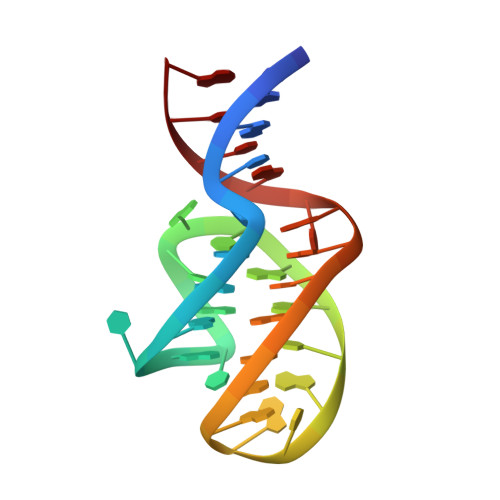Structural Insights into the Mechanism of High-Affinity Binding of Ochratoxin A by a DNA Aptamer.
Xu, G., Zhao, J., Yu, H., Wang, C., Huang, Y., Zhao, Q., Zhou, X., Li, C., Liu, M.(2022) J Am Chem Soc 144: 7731-7740
- PubMed: 35442665
- DOI: https://doi.org/10.1021/jacs.2c00478
- Primary Citation of Related Structures:
7W9N - PubMed Abstract:
A 36-mer guanine (G)-rich DNA aptamer (OBA36) is able to distinguish one atomic difference between ochratoxin analogues A (OTA) and B (OTB), showing prominent recognition specificity and affinity among hundreds of aptamers for small molecules. Why OBA36 has >100-fold higher binding affinity to OTA than OTB remains a long-standing question due to the lack of high-resolution structure. Here we report the solution NMR structure of the aptamer-OTA complex. It was found that OTA binding induces the aptamer to fold into a well-defined unique duplex-quadruplex structural scaffold stabilized by Mg 2+ and Na + ions. OTA does not directly interact with the G-quadruplex, but specifically binds at the junction between the double helix and G-quadruplex through π-π stacking, halogen bonding (X-bond), and hydrophobic interaction. OTB has the same binding site as OTA but lacks the X-bond. The strong X-bond formed between the chlorine atom of OTA and the aromatic ring of C5 is the key to discriminating the strong binding toward OTA. The present research contributes to a deeper insight of aptamer molecular recognition, reveals structural basis of the high-affinity binding of aptamers, and provides a foundation for further aptamer engineering and applications.
- Key Laboratory of Magnetic Resonance in Biological Systems, State Key Laboratory of Magnetic Resonance and Atomic and Molecular Physics, National Center for Magnetic Resonance in Wuhan, Wuhan National Laboratory for Optoelectronics, Wuhan Institute of Physics and Mathematics, Innovation Academy for Precision Measurement Science and Technology, Chinese Academy of Sciences, Wuhan, 430071, People's Republic of China.
Organizational Affiliation:

















